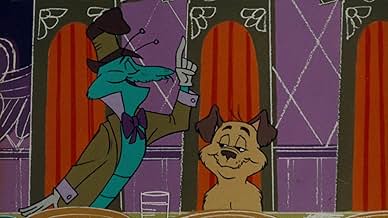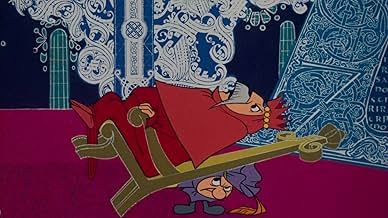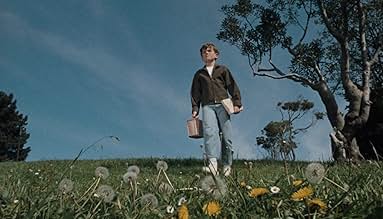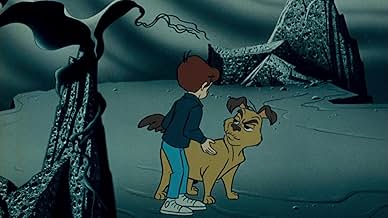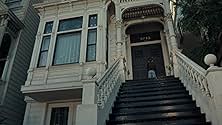"What's to become of Milo?" That was the question posed by "Milo's Theme," the catchy pop tune co-written and produced by Lee Pockriss and Norman Gimbel, which opens Chuck Jones' 1969 film adaptation of Norton Juster's "The Phantom Tollbooth." I've seen the film myself, even during the early years of at least two of the Turner-owned networks: TNT and the Cartoon Network. But I want to take a moment to make these comments on Chuck Jones' Tollbooth because it has been, for the past decade or so, the result of a very special dream of mine. I'm Richard Washington, Founder and Chairman of Electric Pirates Entertainment. When I started EPE some fifteen years ago, one of the company's primary goals was to attempt a remake of the Tollbooth movie. Having seen it for myself, I knew a little something about the film's history. Metro-Goldwyn-Mayer had bought the rights to Tollbooth, along with Juster's second kids' book, The Dot and the Line, in around 1967; shortly thereafter, the management then in place at MGM assigned both properties to animation legend Chuck Jones, who by then was under contract to MGM. Basically, what management said to Chuck was: "Here are a couple of originals by Norton Juster. See what you can do about making one into a short subject; and the other into a 90-minute feature film." Essentially, Chuck did precisely what they'd told him to do. He not only made the short, bringing in actor Robert Morley to read the entire Juster text from The Dot and the Line, he also transformed "The Phantom Tollbooth" into a 90-minute feature --- i.e., an animated cartoon bookended by live-action sequences filmed on location in San Francisco, and starring Eddie Munster himself, Butch Patrick. This, I think, was Butch's last major starring role as a child actor. Once production on the Jones Tollbooth was completed and put in the can, the intent was to release Tollbooth, along with Dot & Line, at the 1969 Christmas season. However, the project somehow became involved in studio politics; the resulting double-bill was never given proper theatrical release until 1971 --- 2 1/2 years later, by which time MGM had fired all of its animation staff, including Jones. Thus what had been planned as MGM's first-ever animated feature ironically became the company's last-ever animated production. And that brings us to the part of this story concerning my very special dream: after having seen the Chuck Jones Tollbooth, I have spent the last several years tackling plans for a live-action, nonmusical remake of "The Phantom Tollbooth" --- in fact, I have actually spoken with Norton Juster himself about this! --- one that would basically correct the mistakes Chuck Jones had no doubt made when he filmed Tollbooth in late 1968. Mr. Juster has expressed his gratitude that I should want a new film version of his beloved book, but officially he has little to say on the matter in light of the fact that Chuck's 1969 film is, of course, part of the Turner Entertainment library. With that I have no quarrel. I'm simply saying that MGM should have waited for the magic of the movies to reach a sufficiently sophisticated stage in order to do proper cinematic justice to "The Phantom Tollbooth." That's why I have long believed that there are only two special effects powerhouses on the Planet which are capable of accomplishing such aims: namely, George Lucas' Industrial Light & Magic and Jim Henson's Creature Shop! With their combined expertise in computer-generated characters, animatronic effects, special make-up techniques and other way-cool elements, only ILM and the Henson Shop could truly make the magic of "The Phantom Tollbooth" come alive --- especially for what George Lucas once called that "generation [doomed to grow up] without fairy tales." And I have wanted nothing less than to be the man to make it all --- and I do mean ALL! --- possible. "But Richard," I sense you're asking, "did you like the movie itself?" Yes. Artistically, Jones' Tollbooth is a visual treat; and its clever motive of taking the concepts of Juster's Dictionopolis and Digitopolis to literal extremes provides the largest degree of 'eye candy.' The film does, sadly fall short by making the two Princesses, Rhyme and Reason, mere silhouettes; that, alas, denies the viewer the pleasure of seeing how beautiful they really are. Of course, considering that this is a Chuck Jones film, one cannot fault the voice talents! Mel Blanc, Daws Butler, June Foray and Les Tremayne were old friends of Chuck's during '67; their voices alone were and are worth the price of the video, if you will (that was for the Amazon.com customers out there!). Lesser-known vocals --- Shep Menken, Patti Gilbert, Candy Candido and Larry Thor --- are also in the cast, along with Hans Conried, in his first non-Disney cartoon voice role (I think). The 9-member ensemble clearly mold and shape Butch Patrick's role of Milo into what he ultimately becomes by story's end: an emotionally stronger, and, perhaps, a remarkably better boy --- but at least, a boy no longer bored by the world. Well, I think I've given you some kind of idea as to what you can expect from Chuck Jones' 1969 version of "The Phantom Tollbooth." Of course, if I can bring ILM and the Henson Shop together, set up a production homebase at London's famous Pinewood Studios (that's where they do the Bond movies), and then scout for locations in and around my beloved New York City, I think I can do for "The Phantom Tollbooth" what Sidney Lumet and designer Tony Walton tried to do for "The Wiz". I estimate that I should have it all coming together and released by .....oh, around the year 2008, or thereabouts. Here's hoping I can do it!



